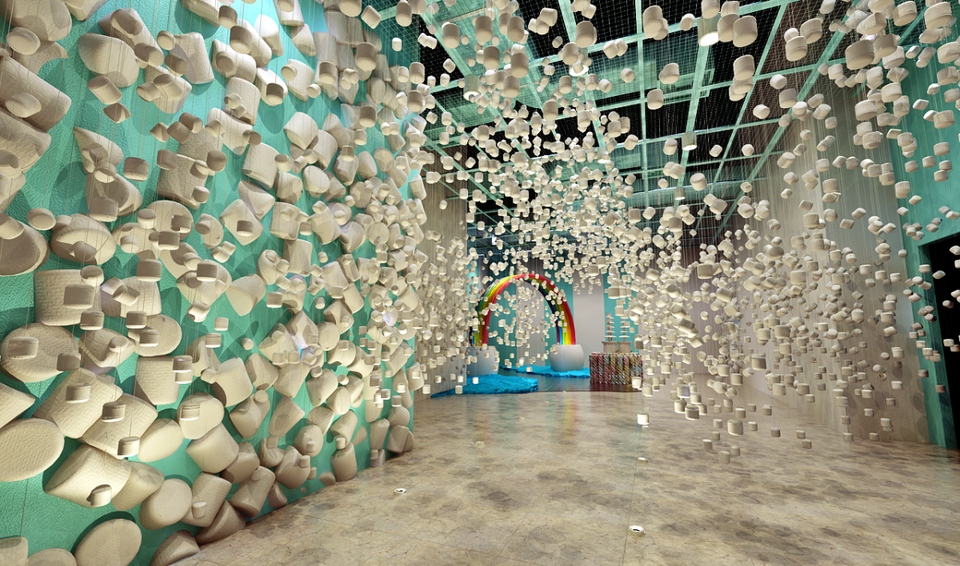A guest or a client

A guest or a client
How would you like to jump in a pool of marshmallows or to find yourself next to a human sized piece of pizza. When I came up with the idea about this article, it was intended to be mainly about the museums I visited in the Netherlands in the last year. Then I asked myself: how can I relate it to our favourite topic of sustainability, which after all can be found everywhere. What I thought of is the term ‘cultural sustainability’- the maintenance of, as defined from UNESCO, both material and immaterial cultural aspects of society (heritage conservation and conservation of different cultural practices, respectively).
Museums are clearly in the material category and under the influence of globalization lately there has been a (maybe unsustainable) shift in the way people perceive museums, and art in general, and also in the way those perceive their visitors. Something that can be noticed in the last few years is a global trend of the museum as a place of interaction, where people can take photos, can touch and feel the art that is presented to them- you can walk in somebody’s dream or be in a room full of mirrors. Here a question about what can be called art arises but I maybe should leave it as a topic of another article. People’s expectations for their visit in a museum are gradually changing, more interactive ones are preferred, and are challenging the ones where paintings, sculptures or historical artefacts are closed behind a thick piece of glass.
In the same time the way museums treat their visitors has adapted. I found an interesting article about the way visitors nowadays are mostly seen as clients whose needs have to be met. For example there are museums that are open to or especially made for children. Also there are museum shops that keep coming up with creative ideas, some of them in my opinion a bit extreme: I’ve seen a nail file with the image of a famous painting. In the past this relationship has been slightly different- visitors have been treated as guests, in other words, they’ve had the privilege to be admitted to see the collection of the museum.
However, this whole shift is not definite and it has both positive and negative sides. The traditional museums are not likely to lose all of their visitors. There will always be people interested in the chance to take a closer look at a masterpiece, to stand close to it and to feel the spirit of the person that created it. Some interactive museums, on the other hand, turn the attention to visitors such as children, they give a scene for contemporary artist, and others simply give people unique experiences. Like in many cases, the combination of both types turns out to be successful. A good example that I can give from my own experience are the museums in the Netherlands. I can’t think of even one where there wasn’t an interactive twist. Here I’ve made a list of the ones where my museumkaart took me, and that left a nice impression:
-
Classic & modern art (traditional museums): Rijksmuseum, Van Gogh Museum, Utrecht centraal museum, Mauritshuis, Boijmans Van Beuningen- next to the great collections off paintings they have, it must be appreciated that there was always something fun for the children or for the adults to do besides enjoying passively the paintings
-
Contemporary art: Stedelijk, Eye- although contemporary art is in many cases interactive itself it was interesting to see how the different spaces are used by the different artists, I also visited a performance art VR experience related to climate change in the film museum that was very interesting (the museum shop of both of them had great postcards and other cool stuff)
-
Utrecht: Speelklok- I listened to an organ version of “Let it go”; Nijntje- a great place for children, it was a big playground
-
Most interactive one: Nemo- there was literally nothing that wasn’t interactive so it was a really fun experience.
Looking back to where I started, cultural sustainability seems to be a dynamic concept since culture is constantly changing under the influence of people's values, the development of technology and its use in the creation of art. However, it could be argued whether the development of new trends in the museums is a way of sustaining culture by adapting it to these changes, or if it has more of a disruptive effect by shifting the attention from art itself to the experience people have in the museums.



















Comments
Log in to read and post comments